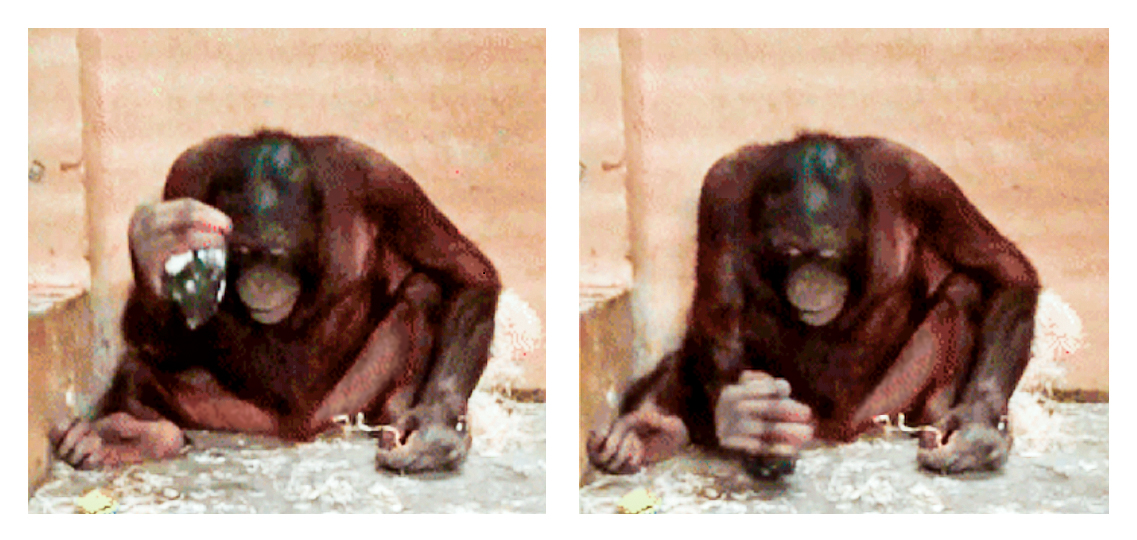Press Releases Archive
16.02.2022
Orangutans show pre-requisites for stone tool technologies
Zoo-living orangutans can spontaneously use sharp stones as cutting tools, a behavior previously unobserved in untrained great apes
Basic skills for using stone tools may be more widespread among primates than we previously thought: A study led by researchers from the University of Tübingen in collaboration with the Max Planck Institute of Evolutionary Anthropology in Leipzig and the University of Barcelona shows that orangutans spontaneously recognize and use human-made sharp stones as cutting tools. In this re-gard, their skills even exceeded those of chimpanzees, one of our closest living relatives and the only other ape species whose spontaneous abilities in this task had been previously tested. The find-ings were published in the journal PLOS ONE.
The results have added a new piece to the puzzle of the technological origins of our species, say Dr. Alba Motes-Rodrigo and Dr. Claudio Tennie. The study, financed by the European Research Council’s STONECULT grant, tested the abilities of five untrained, unenculturated orangutans in two different European zoos to make and use stone tools on their own and after exposure to human demonstrations.
The orangutans were presented with baited puzzle boxes and also offered sharp pieces of flaked stone. In their attempts to open the boxes, one orangutan used a human-made sharp stone flake as a tool to open the puzzle box. In addition, they made (but did not use) their own sharp stone chips by striking stones against a hard surface.
One of the major innovations that have taken place in the evolution of our species is the production and use of sharp stone tools. Stone tools allowed our hominin ancestors to incorporate more nutri-tious food into their diet, as well as potentially allowed them to manufacture and modify other tools with their help.
Most researchers agree that the systematic production and use of stone tools evolved from a set of simpler, more basic behaviors and abilities. At the very least, hominins must have been able to strike a suitable stone against another stone or a hard surface to detach sharp stone pieces. Similarly, in order to use a stone as a tool, hominins must have been able to recognize sharp stone edges as usable tools and to manipulate them in a way that allowed them to cut into different substrates.
The findings of this study reveal that two pre-requisites necessary for the development of stone technologies are spontaneously present in orangutans – the use of sharp stones as cutting tools and the ability to strike a stone against a hard object or surface, which can lead to the detachment of sharp stone pieces. These results contrast with those of an earlier study, which instead assumed that such abilities would require human demonstrations to develop.
“Interestingly, the orangutans tested in the study did not combine their abilities by making and using their own stone tools even after they saw human demonstrations,” says Motes-Rodrigo. “It therefore seems that the ability to intentionally make sharp stones to then use as cutting tools might have been unique to the hominin lineage among apes.”
ERC project STONECULT: https://sites.google.com/view/stonecult
Publication:
Alba Motes-Rodrigo, Shannon P. McPherron, Will Archer, R. Adriana Hernandez-Aguilar and Claudio Tennie: Experimental investigation of orangutans lithic percussive and sharp stone tool behaviours, PLOS ONE, https://journals.plos.org/plosone/article?id=10.1371/journal.pone.0263343
Contact:
Dr. Claudio Tennie
University of Tübingen
Department of Early Prehistory and Quaternary Ecology
claudio.tenniespam prevention@uni-tuebingen.de
https://sites.google.com/view/claudiotennie/home
Dr. Alba Motes-Rodrigo
University of Lausanne
Department of Ecology and Evolution
albamotes7spam prevention@gmail.com
https://sites.google.com/view/alba-motes-rodrigo/home
Contact for press:
Eberhard Karls Universität Tübingen
Public Relations Department
Dr. Karl Guido Rijkhoek
Director
Antje Karbe
Press Officer
Phone +49 7071 29-76789
Fax +49 7071 29-5566
antje.karbespam prevention@uni-tuebingen.de
www.uni-tuebingen.de/en/university/news-and-publications

